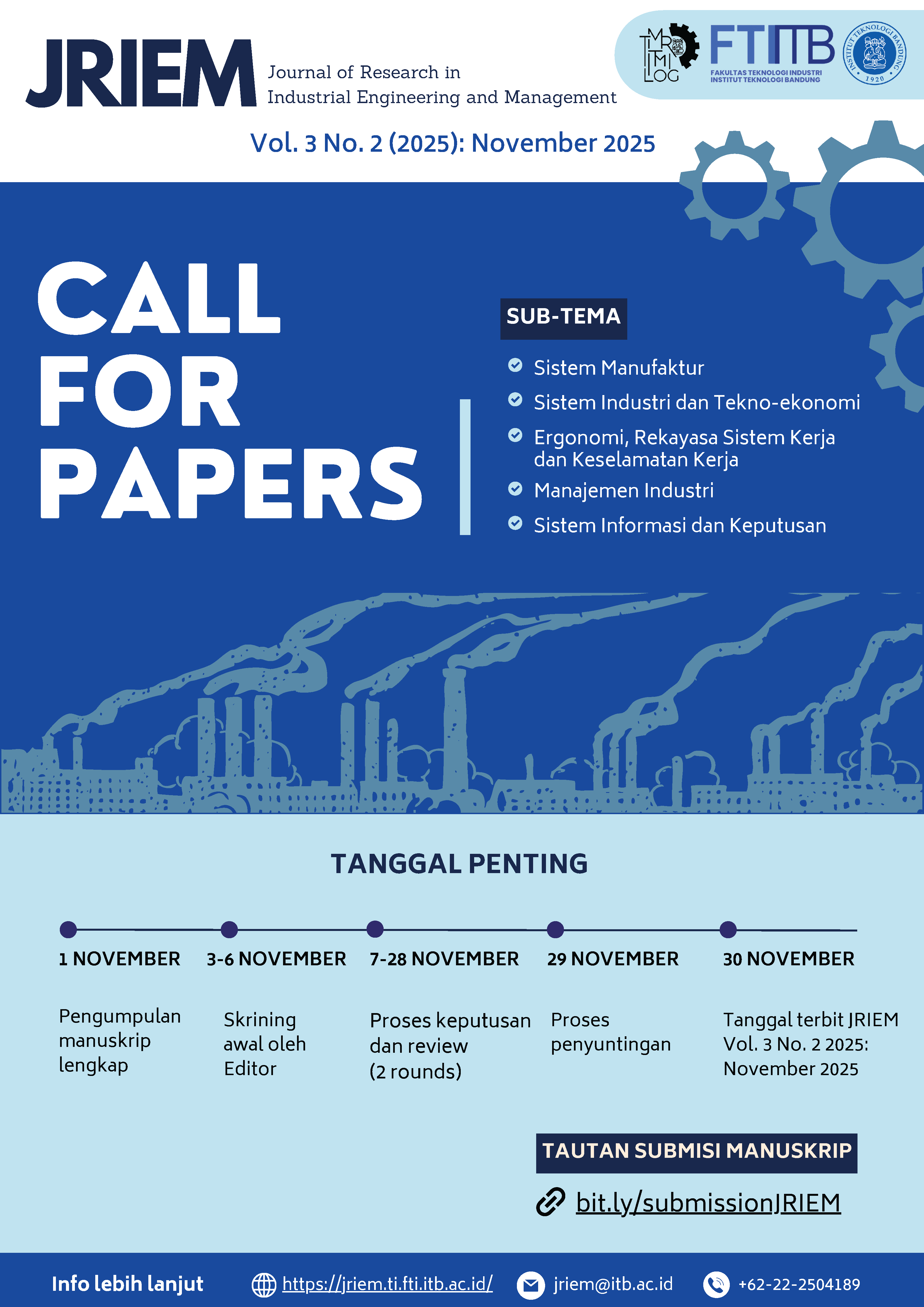Penerimaan Teknologi Artificial Intelligence (AI) di Proses Rekrutmen dan Seleksi Oleh Pelamar Kerja
DOI:
https://doi.org/10.61221/jriem.v3i1.56Kata Kunci:
Recruitment and Selection, Artificial Intelligence, Job Applicant, Technology AcceptanceAbstrak
Penggunaan teknologi dalam proses rekrutmen dan seleksi berkembang seiring dengan persaingan organisasi untuk mengidentifikasi, memilih, dan mempertahankan talenta terbaik. Teknologi Artificial Intelligence (AI) dalam proses rekrutmen dan seleksi, yang menawarkan berbagai keuntungan dari perspektif organisasi. Namun, persepsi teknologi AI dari sudut pandang pelamar kerja belum banyak dibahas dalam literatur, sedangkan hal ini menjadi salah satu isu utama yang dapat mempengaruhi berbagai sikap dan perilaku pelamar kerja pasca-proses rekrutmen dan seleksi. Penelitian ini berfokus pada penerimaan teknologi AI oleh pelamar kerja menggunakan model-model teoritis penerimaan teknologi untuk memahami faktor-faktor yang memengaruhi intensi pelamar kerja menggunakan teknologi AI. Metode statistika PLS-SEM digunakan dalam pengolahan data menggunakan perangkat lunak SmartPLS. Berdasarkan 166 responden di Jabodetabek dan Bandung yang belum pernah mengikuti proses rekrutmen dan seleksi yang menggunakan teknologi AI, didapatkan hasil penelitian bahwa persepsi manfaat, persepsi kemudahan, dan kepercayaan memiliki dampak positif terhadap intensi menggunakan AI, dengan sikap berperan sebagai mediator. Persepsi manfaat dan persepsi kemudahan memiliki dampak positif secara langsung terhadap intensi menggunakan AI. Selain itu, sikap dan pengaruh sosial juga berpengaruh positif pada intensi menggunakan AI. Sementara itu, persepsi pengetahuan tidak memiliki pengaruh positif pada intensi menggunakan AI dalam proses rekrutmen dan seleksi oleh pelamar kerja
Kata kunci: Rekrutmen dan Seleksi, Artificial Intelligence, Pelamar Kerja, Penerimaan Teknologi
Referensi
Ajzen, I. (1991). The theory of planned behavior. Organizational Behavior and Human Decision Processes, 50(2), 179–211. https://doi.org/10.1016/0749-5978(91)90020-T
Brenner, F. S., Ortner, T. M., & Fay, D. (2016). Asynchronous video interviewing as a new technology in personnel selection: The applicant’s point of view. Frontiers in Psychology, 7(JUN). https://doi.org/10.3389/fpsyg.2016.00863
Buil, I., Catalán, S., & Martínez, E. (2020). Understanding applicants’ reactions to gamified recruitment. Journal of Business Research, 110(December 2019), 41–50. https://doi.org/10.1016/j.jbusres.2019.12.041
Choung, H., David, P., & Ross, A. (2022). Trust in AI and Its Role in the Acceptance of AI Technologies. International Journal of Human-Computer Interaction. https://doi.org/10.1080/10447318.2022.2050543
Davis, F. D. (1989). Perceived usefulness, perceived ease of use, and user acceptance of information technology. MIS Quarterly: Management Information Systems, 13(3), 319–339. https://doi.org/10.2307/249008
Gado, S., Kempen, R., Lingelbach, K., & Bipp, T. (2022). Artificial intelligence in psychology: How can we enable psychology students to accept and use artificial intelligence? Psychology Learning and Teaching, 21(1), 37–56. https://doi.org/10.1177/14757257211037149
Garcia, R. L. F., Huang, Y. K., & Kwok, L. (2023). Virtual interviews vs. LinkedIn profiles: Effects on human resource managers’ initial hiring decisions. Tourism Management, 94(September 2022), 104659. https://doi.org/10.1016/j.tourman.2022.104659
Hair, J. F., Risher, J. J., Sarstedt, M., & Ringle, C. M. (2019). The Results of PLS-SEM Article information. European Business Review, 31(1), 2–24.
Hair, J. F., Sarstedt, M., Hopkins, L., & Kuppelwieser, V. G. (2014). Partial least squares structural equation modeling (PLS-SEM): An emerging tool in business research. European Business Review, 26(2), 106–121. https://doi.org/10.1108/EBR-10-2013-0128
Horodyski, P. (2023). Applicants’ perception of artificial intelligence in the recruitment process. Computers in Human Behavior Reports, 11(June), 100303. https://doi.org/10.1016/j.chbr.2023.100303
Hunkenschroer, A. L., & Luetge, C. (2022). Ethics of AI-Enabled Recruiting and Selection: A Review and Research Agenda. In Journal of Business Ethics (Vol. 178, Issue 4). Springer Netherlands. https://doi.org/10.1007/s10551-022-05049-6
Jia, Q., Guo, Y., Li, R., Li, Y., & Chen, Y. (2018). A conceptual artificial intelligence application framework in human resource management. Proceedings of the International Conference on Electronic Business (ICEB), 2018-Decem, 106–114.
Jones, J. W., Brasher, E. E., & Huff, J. W. (2002). Innovations in integrity-based personnel selection: Building a technology-friendly assessment. International Journal of Selection and Assessment, 10(1–2), 87–97. https://doi.org/10.1111/1468-2389.00195
Kelly, S., Kaye, S. A., & Oviedo-Trespalacios, O. (2023). What factors contribute to the acceptance of artificial intelligence? A systematic review. Telematics and Informatics, 77(March 2022), 101925. https://doi.org/10.1016/j.tele.2022.101925
Michaels, E., Axelrod, E. M. H. H. J. B., Handfield-Jones, H., Axelrod, B., Books24x7, I., & Press, H. B. (2001). The War for Talent. January 1998, 1–8. https://books.google.mv/books?id=simZCd_YUC4C
Ochmann, J., & Laumer, S. (2020). AI recruitment: Explaining job seekers’ acceptance of automation in human resource management. Proceedings of the 15th International Conference on Business Information Systems 2020 “Developments, Opportunities and Challenges of Digitization”, WIRTSCHAFTSINFORMATIK 2020. https://doi.org/10.30844/wi_2020_q1
Ore, O., & Sposato, M. (2022). Opportunities and risks of artificial intelligence in recruitment and selection. International Journal of Organizational Analysis, 30(6), 1771–1782. https://doi.org/10.1108/IJOA-07-2020-2291
Ployhart, R. E., Schmitt, N., & Tippins, N. T. (2017). Solving the Supreme Problem: 100 Years of selection and recruitment at the Journal of Applied Psychology. Journal of Applied Psychology, 102(3), 291–304. https://doi.org/10.1037/apl0000081
Ryan, A. M., & Ployhart, R. E. (2014). A Century of Selection. September 2013, 1–25. https://doi.org/10.1146/annurev-psych-010213-115134
van Esch, P., & Black, J. S. (2019). Factors that influence new generation candidates to engage with and complete digital, AI-enabled recruiting. Business Horizons, 62(6), 729–739. https://doi.org/10.1016/j.bushor.2019.07.004
van Esch, P., Black, J. S., & Arli, D. (2021). Job candidates’ reactions to AI-Enabled job application processes. AI and Ethics, 1(2), 119–130. https://doi.org/10.1007/s43681-020-00025-0
Venkatesh, V., & Davis, F. D. (2000). Theoretical extension of the Technology Acceptance Model: Four longitudinal field studies. Management Science, 46(2), 186–204. https://doi.org/10.1287/mnsc.46.2.186.11926
Venkatesh, V., Morris, M. G., Davis, G. B., & Davis, F. D. (2003). User acceptance of information technology: Toward a unified view. MIS Quarterly: Management Information Systems, 27(3), 425–478. https://doi.org/10.2307/30036540
Unduhan
Diterbitkan
Cara Mengutip
Terbitan
Bagian
Lisensi
Hak Cipta (c) 2025 Muhammad Putro, Joko Siswanto

Artikel ini berlisensi Creative Commons Attribution 4.0 International License.




